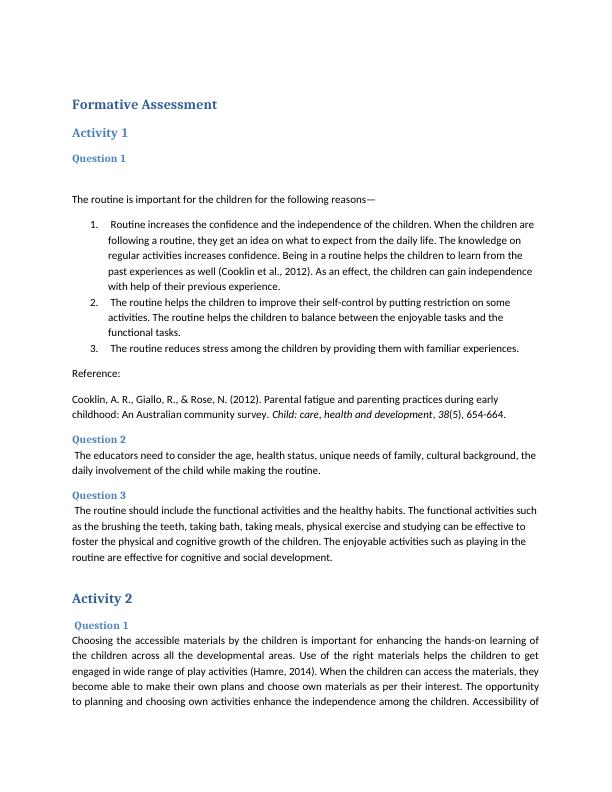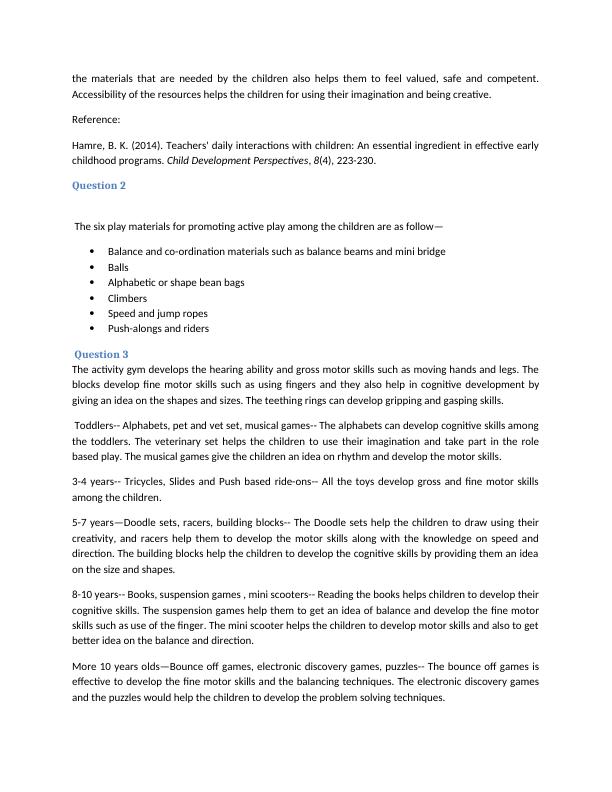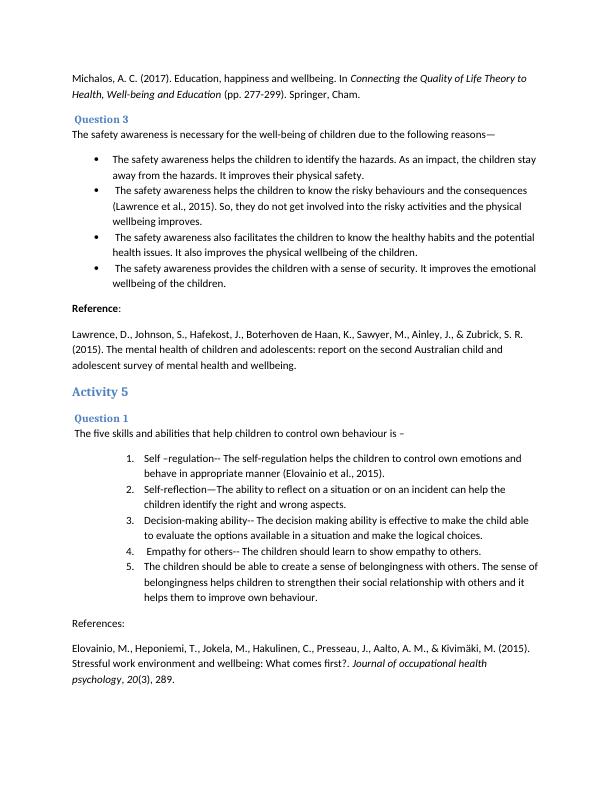Ask a question from expert
Formative Assessment for Children's Development and Wellbeing
17 Pages7658 Words467 Views
Added on 2019-09-22
About This Document
This formative assessment covers various aspects of children's development and wellbeing, including routine, accessible materials, safety awareness, responsibility, one-to-one interaction, and positive traits. It provides expert advice and tips for educators and parents to support children's growth and development. References are included for further reading.
Formative Assessment for Children's Development and Wellbeing
Added on 2019-09-22
BookmarkShareRelated Documents
Formative AssessmentActivity 1Question 1The routine is important for the children for the following reasons—1. Routine increases the confidence and the independence of the children. When the children are following a routine, they get an idea on what to expect from the daily life. The knowledge on regular activities increases confidence. Being in a routine helps the children to learn from the past experiences as well (Cooklin et al., 2012). As an effect, the children can gain independence with help of their previous experience.2. The routine helps the children to improve their self-control by putting restriction on some activities. The routine helps the children to balance between the enjoyable tasks and the functional tasks.3. The routine reduces stress among the children by providing them with familiar experiences.Reference:Cooklin, A. R., Giallo, R., & Rose, N. (2012). Parental fatigue and parenting practices during early childhood: An Australian community survey.Child: care, health and development,38(5), 654-664.Question 2 The educators need to consider the age, health status, unique needs of family, cultural background, the daily involvement of the child while making the routine.Question 3 The routine should include the functional activities and the healthy habits. The functional activities suchas the brushing the teeth, taking bath, taking meals, physical exercise and studying can be effective to foster the physical and cognitive growth of the children. The enjoyable activities such as playing in the routine are effective for cognitive and social development.Activity 2 Question 1Choosing the accessible materials by the children is important for enhancing the hands-on learning ofthe children across all the developmental areas. Use of the right materials helps the children to getengaged in wide range of play activities (Hamre, 2014). When the children can access the materials, theybecome able to make their own plans and choose own materials as per their interest. The opportunityto planning and choosing own activities enhance the independence among the children. Accessibility of

the materials that are needed by the children also helps them to feel valued, safe and competent.Accessibility of the resources helps the children for using their imagination and being creative.Reference:Hamre, B. K. (2014). Teachers' daily interactions with children: An essential ingredient in effective earlychildhood programs.Child Development Perspectives,8(4), 223-230.Question 2 The six play materials for promoting active play among the children are as follow—Balance and co-ordination materials such as balance beams and mini bridge BallsAlphabetic or shape bean bagsClimbersSpeed and jump ropesPush-alongs and riders Question 3The activity gym develops the hearing ability and gross motor skills such as moving hands and legs. Theblocks develop fine motor skills such as using fingers and they also help in cognitive development bygiving an idea on the shapes and sizes. The teething rings can develop gripping and gasping skills. Toddlers-- Alphabets, pet and vet set, musical games-- The alphabets can develop cognitive skills amongthe toddlers. The veterinary set helps the children to use their imagination and take part in the rolebased play. The musical games give the children an idea on rhythm and develop the motor skills.3-4 years-- Tricycles, Slides and Push based ride-ons-- All the toys develop gross and fine motor skillsamong the children.5-7 years—Doodle sets, racers, building blocks-- The Doodle sets help the children to draw using theircreativity, and racers help them to develop the motor skills along with the knowledge on speed anddirection. The building blocks help the children to develop the cognitive skills by providing them an ideaon the size and shapes.8-10 years-- Books, suspension games , mini scooters-- Reading the books helps children to develop theircognitive skills. The suspension games help them to get an idea of balance and develop the fine motorskills such as use of the finger. The mini scooter helps the children to develop motor skills and also to getbetter idea on the balance and direction.More 10 years olds—Bounce off games, electronic discovery games, puzzles-- The bounce off games iseffective to develop the fine motor skills and the balancing techniques. The electronic discovery gamesand the puzzles would help the children to develop the problem solving techniques.

Activity 3The balance skills can be considered as an emerging activity for the toddlers. The balancing skill can be supported in the following ways—Enabling the children to stand on one foot. Standing on one foot helps the children to build strengths and improve the balance. Encouraging the children to ride the ladder is also effective for improving balance. Getting involved into Yoga is also effective to improve the balance.Activity 4Question 1Wellbeing can be described as a combination of the quality of life and prosperity, sound health andsustainable communities. Wellbeing can be defined by the measure of personal assessment of thequality of life of an individual and the experiences (Michalos, 2017). Wellbeing gives a measurement ofhow an individual is doing and how he/ she are being a part of the community (Steptoe et al., 2015).Wellbeing can be measured by different dimensions such as the natural environment, relationship of anindividual with others, personal conception of wellbeing with others, health, activities of individual,financial resources available to an individual, the education, economy, governance and skills developedby an individual.References:Michalos, A. C. (2017). Education, happiness and wellbeing. InConnecting the Quality of Life Theory toHealth, Well-being and Education(pp. 277-299). Springer, Cham.Steptoe, A., Deaton, A., & Stone, A. A. (2015). Subjective wellbeing, health, and ageing.The Lancet,385(9968), 640-648.Question 2Five things to educate children about physical and mental wellbeing—Educating the children about personal hygiene to ensure physical wellbeing Reinforcing the positive behaviour among children so that they behave in the right wayDeveloping skills and competencies among the children so that they can explore new experiences Creating a sense of belonging among the children can be effective to enable them to make social relationships (Michalos, 2017). Development of social relationship, in turn, is useful for ensuring mental wellbeing.The educators can also encourage the children to help others. Helping others strengthen the social relationship and improve the mental wellbeing of an individual.Reference:

Michalos, A. C. (2017). Education, happiness and wellbeing. InConnecting the Quality of Life Theory to Health, Well-being and Education(pp. 277-299). Springer, Cham. Question 3The safety awareness is necessary for the well-being of children due to the following reasons—The safety awareness helps the children to identify the hazards. As an impact, the children stay away from the hazards. It improves their physical safety. The safety awareness helps the children to know the risky behaviours and the consequences (Lawrence et al., 2015). So, they do not get involved into the risky activities and the physical wellbeing improves. The safety awareness also facilitates the children to know the healthy habits and the potential health issues. It also improves the physical wellbeing of the children. The safety awareness provides the children with a sense of security. It improves the emotional wellbeing of the children.Reference:Lawrence, D., Johnson, S., Hafekost, J., Boterhoven de Haan, K., Sawyer, M., Ainley, J., & Zubrick, S. R. (2015). The mental health of children and adolescents: report on the second Australian child and adolescent survey of mental health and wellbeing.Activity 5 Question 1 The five skills and abilities that help children to control own behaviour is –1.Self –regulation-- The self-regulation helps the children to control own emotions and behave in appropriate manner (Elovainio et al., 2015).2.Self-reflection—The ability to reflect on a situation or on an incident can help the children identify the right and wrong aspects.3.Decision-making ability-- The decision making ability is effective to make the child able to evaluate the options available in a situation and make the logical choices.4. Empathy for others-- The children should learn to show empathy to others.5.The children should be able to create a sense of belongingness with others. The sense ofbelongingness helps children to strengthen their social relationship with others and it helps them to improve own behaviour.References:Elovainio, M., Heponiemi, T., Jokela, M., Hakulinen, C., Presseau, J., Aalto, A. M., & Kivimäki, M. (2015). Stressful work environment and wellbeing: What comes first?.Journal of occupational health psychology,20(3), 289.

End of preview
Want to access all the pages? Upload your documents or become a member.
Related Documents
Assessment on Importance of Routine for Childrenlg...
|20
|8946
|194
Formative Assessment for Children's Development and Wellbeinglg...
|27
|11581
|328
Environment in Early Childhood Settingslg...
|10
|2270
|395
Assignment on Wellbeing of A Childlg...
|9
|2250
|28
Early Childhood Curriculum Modelslg...
|12
|3709
|110
Early Childhood Education and Carelg...
|13
|2628
|254